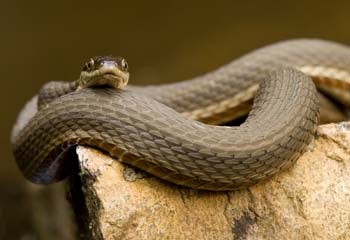SCIENTIFIC NAME:
Regina septemvittata
OTHER NAMES:
Willow Snake, Leather Snake
STATUS:
Fairly common to uncommon. Nearly statewide, but apparently absent from Coastal Plain west of Tombigbee River, and from southern portions of Baldwin County. Believed to be declining, especially in southern Alabama. MODERATE CONSERVATION CONCERN.
DESCRIPTION:
A relatively small aquatic snake with a slender body measuring 15-24 inches long. Females are generally larger than males. Usually brown in color but can vary from gray to olive green, with three dark stripes which are faint running along the upper body and yellow or golden stripe along the lower sides of the body. The belly is yellowish and marked with four brown stripes (two along the middle and two along the sides). The scales are keeled. Juveniles have the same appearance as adults.
DISTRIBUTION:
Found in the eastern US from the great lakes south through central Georgia and down to the Florida panhandle, west to eastern Mississippi and east to the Central Carolinas. Found throughout Alabama, except for extreme southwestern counties (Washington and Mobile). This species is believed to be in decline, especially in the southern part of the state because of siltation and channelization of small streams.
HABITAT:
Queen snakes are highly aquatic snakes most commonly found in smaller streams and rivers with moving water, but can also be found in ponds and lakes. Often found in rocky aquatic habitats with an abundance of crayfish. They are primarily active during the day and can be found swimming in search of food or under rocks or debris near the edge of the water. They are occasionally found on land crossing roads near aquatic habitats at dusk. Often seen basking on limbs overhanging water.
FEEDING HABITS:
This and other snakes in the Genus Regina are known as crayfish snakes. They feed primarily on soft shelled crayfish which have recently shed.
LIFE HISTORY AND ECOLOGY:
Mating occurs during the spring of the year with females giving birth to 5-23 live offspring during the summer months. Most of their lives queen snakes are found in the water, but occasionally found on land after it has rained.
REFERENCES:
Mount, R. 1975. The Reptiles and Amphibians of Alabama. Auburn Printing Co., Auburn, AL.
Conant, R. and J. Collins. 1998. Peterson Field Guides: Reptiles and Amphibians Eastern/Central North America. Houghton Mifflin Company. New York, NY.
https://srelherp.uga.edu/snakes/queen-snake/
AUTHOR:
Seth Maddox, Wildlife Biologist, Alabama Division of Wildlife and Freshwater Fisheries






